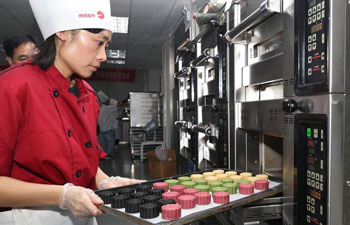WASHINGTON, Sept. 22 (Xinhua) -- American scientists used genomic data to identify five distinct groups of DNA sites that cause distinct forms of type 2 diabetes, potentially allowing physicians to give interventions based on the cause rather than the symptoms of the disease.
The study published in this week's PLOS Medicine revealed that inherited genetic changes might underlie the variability observed among patients in the clinic, with several pathophysiological processes potentially leading to high blood sugar and its resulting consequences.
"When treating type 2 diabetes, we have a dozen or so medications we can use, but after you start someone on the standard algorithm, it's primarily trial and error," said the paper's senior author Jose Florez, an endocrinologist at Massachusetts General Hospital (MGH).
"We need a more granular approach that addresses the many different molecular processes leading to high blood sugar," said Florez.
Florez's team found that DNA variations could be grouped into clusters based on how they impact diabetes-related traits. For instance, genetic changes linked to high triglyceride levels are likely to work through the same biological processes.
Miriam Udler, an endocrinologist at MGH and postdoctoral researcher in the Florez lab, applied a "soft-clustering" approach that allowed each variant to fall into more than one cluster.
"The soft-clustering method is better for studying complex diseases, in which disease-related genetic sites may regulate not just one gene or process, but several," said Udler.
The new algorithm with a computational tool revealed five clusters of genetic variants distinguished by distinct underlying cellular processes, within the existing major divisions of insulin-deficient and insulin-resistant disease.
Two of these clusters contain variants that suggest pancreatic beta cells aren't working properly, but that differ in their impacts on levels of the insulin precursor, proinsulin, according to the study.
The other three clusters contain DNA variants related to insulin resistance, including one cluster mediated by obesity, one defined by disrupted metabolism of fats in the liver, and one driven by defects in the distribution of fat within the body or lipodystrophy, according to the study.
The researchers gathered data from four independent cohorts of patients with type 2 diabetes and first calculated the patients' individual genetic risk scores for each cluster.
They found nearly a third of patients scored highly for only one predominant cluster, suggesting that their diabetes may be driven predominantly by a single biological mechanism.
"The clusters from our study seem to recapitulate what we observe in clinical practice," said Florez. "Now we need to determine whether these clusters translate to differences in disease progression, complications, and response to treatment."
"This study has given us the most comprehensive view to date of the genetic pathways underlying a common illness," said Udler.

















